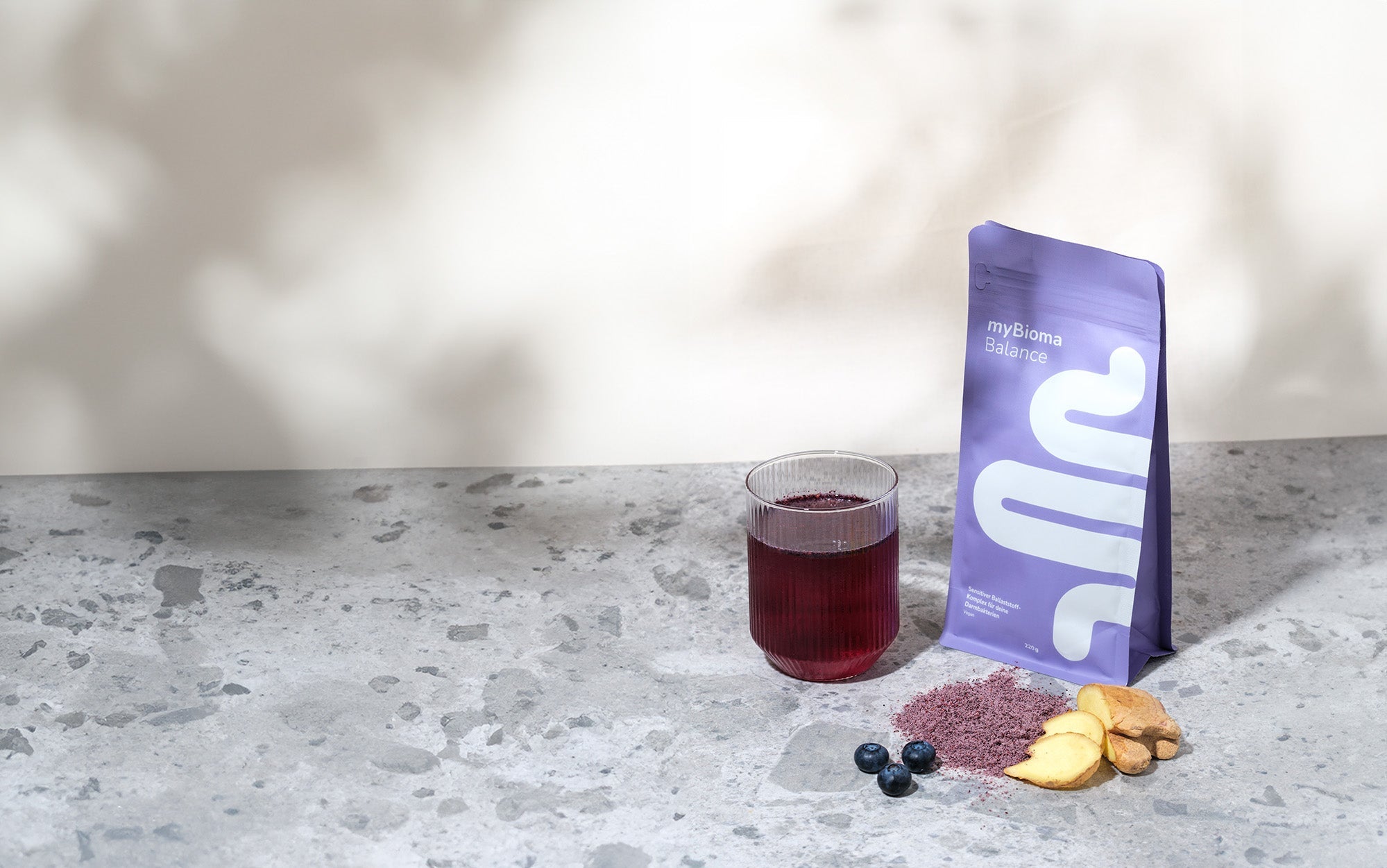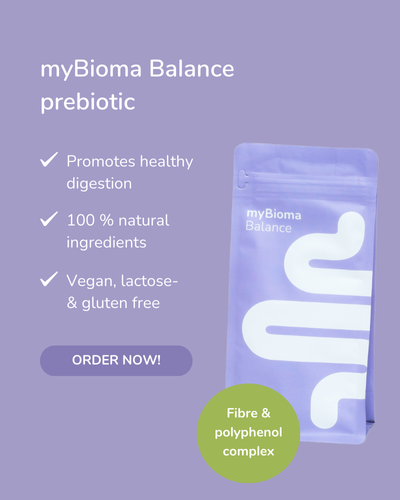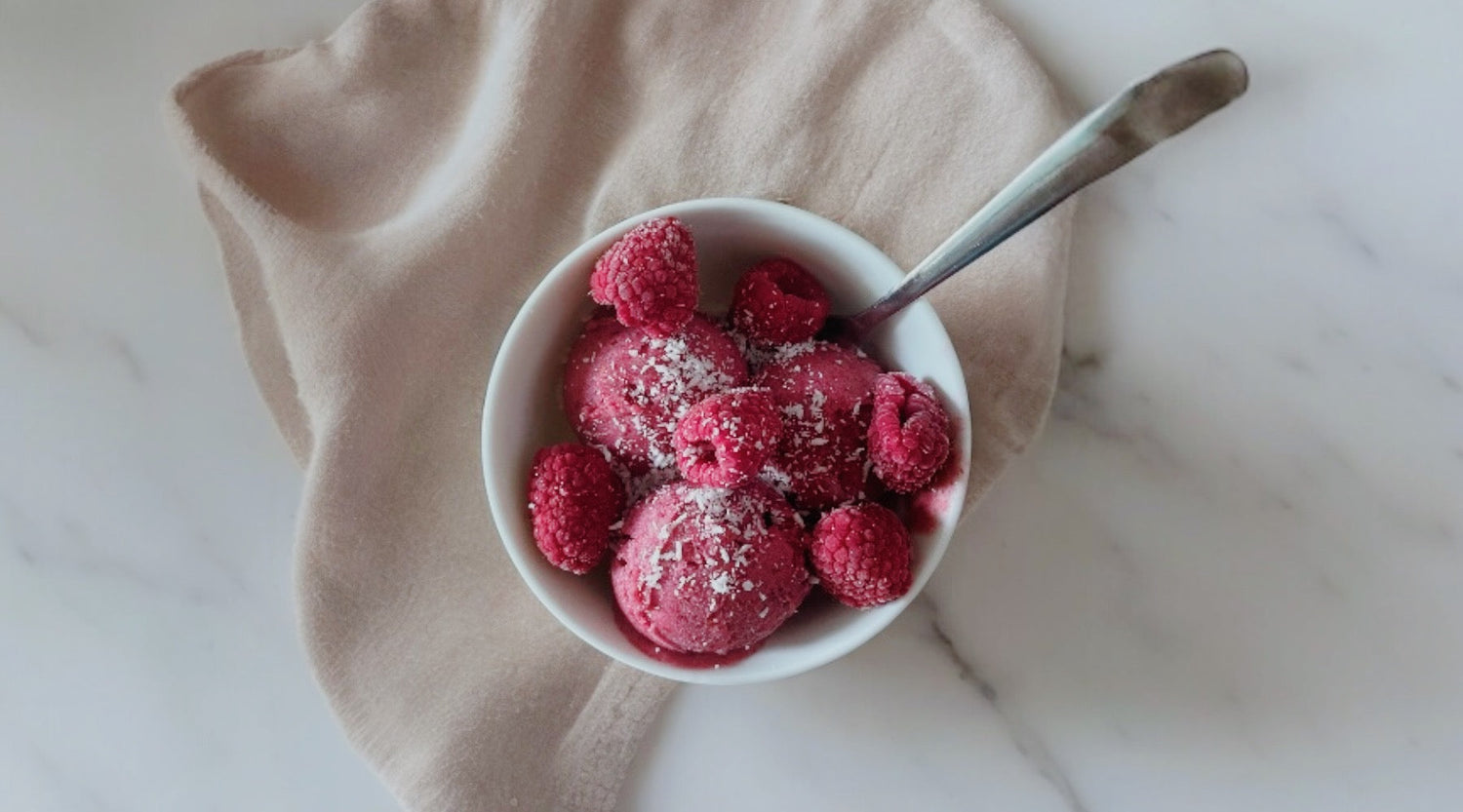The ingredients for our prebiotic myBioma Balance were selected with the utmost care and based on scientific studies. We prioritize quality over quantity in our ingredient list. This means we use only a few, highly effective ingredients to create a product that is especially well-tolerated and offers maximum health benefits. Our formula is designed even for those who often experience flatulence, discomfort, or diarrhea from common prebiotic supplements, as well as for individuals with irritable bowel syndrome (IBS).
What are prebiotics and why are they good for us?
Prebiotics are defined as "substrates that are selectively used by host microorganisms and provide a health benefit" (1). More specifically, they are non-digestible food components, typically fiber, that are fermented by gut bacteria, meaning they are broken down and converted into other substances. This process leads to the growth and increased activity of beneficial gut bacteria, improving gut health. For more information, you can read this blog article: Prebiotics and probiotics for your health.
The ingredients of myBioma Balance
The four ingredients of the prebiotic are all of natural origin and 100% vegan and gluten-free. The main sources of fiber are acacia fiber and guar gum. They are complemented by wild blueberry and ginger root, which provide additional fiber and beneficial polyphenols. Polyphenols are secondary plant compounds that support digestion and have antioxidativ properties (2,3).
Curious about the specific benefits of each ingredient? We've revealed the details here:
Acacia fiber

The prebiotic acacia fiber is obtained from the milk fibers of the acacia tree.
Acacia fiber, sometimes called gum arabic, is a soluble fiber that offers multiple health benefits:
-
Prebiotic effect with very good tolerability
Consumption of acacia fiber promotes the growth of beneficial gut bacteria such as lactobacilli, bifidobacteria, and bacteroides (4–6). Unlike many other fiber sources, acacia fiber is very well tolerated and typically does not cause intestinal issues like flatulence, abdominal cramps, or diarrhea (4,5,7,8). -
Supporting metabolic health
Studies indicate that acacia fiber can help regulate weight, promote a feeling of fullness, reduce blood sugar spikes, and positively influence fat metabolism. Improving fat tissue function can stabilize blood sugar levels, enhance insulin sensitivity, and lower the risk of metabolic diseases such as type 2 diabetes and cardiovascular disease among others (7–9).
Guar gum (partially hydrolysed)

Guar gum is obtained from the guar bean.
Guar gum is extracted from the seeds of the guar bean and undergoes a special processing method (partial hydrolysis) to eliminate its swelling properties, making it more accessible to bacteria. This prebiotic fiber source is known for the following properties:
-
Relief of irritable bowel symptoms and digestive problems
In individuals with irritable bowel syndrome (IBS), various studies have shown that partially hydrolyzed guar gum can improve symptoms. This fiber source can enhance stool consistency in cases of diarrhea, alleviate constipation, and reduce flatulence (10–16). - Support of the intestinal barrier
In the large intestine, bacteria convert plant fiber into short-chain fatty acids (SCFAs), which help maintain an intact intestinal mucosa (11). Partially hydrolyzed guar gum can decrease the number and activity of bacteria that harm the intestinal mucosa. If the mucosa is compromised, it cannot perform its crucial barrier function, allowing unwanted substances to enter the body and trigger inflammation. This can lead to multiple ailments including digestive issues and even mental health (10). - Improving skin health
Partially hydrolyzed guar gum supports skin integrity and improves moisture levels, helping keep your skin supple and healthy while counteracting dryness (11). For more information about the connection between the gut microbiome and skin health, check out this blog post: The skin - the mirror of the gut. - Promoting beneficial gut bacteria
Guar gum fiber can increase the diversity of the gut microbiome, a key indicator of gut health. Various studies have shown that its consumption can promote the growth of beneficial gut bacteria like bifidobacteria while suppressing the spread and activity of potentially harmful bacteria (10,11,14,16).
Wild blueberry

The vibrant color of wild blueberries indicates their high content of valuable polyphenols.
This ingredient provides the pleasant fruity taste, the purple color and, as a food rich in polyphenols and fiber, supports your health in many ways:
- Colorful health boosters
Wild blueberries are particularly rich in polyphenols such as anthocyanins. As antioxidants, these secondary plant substances can support your immune system, protect against diseases and infections thanks to their antibacterial effect and can even have a protective effect on brain health (3). - Polyphenols and gut microbiome
Only a small part of the polyphenols are absorbed in the small intestine and used directly. The majority reach the large intestine and serve as food for your gut bacteria. Polyphenols therefore contribute to a diverse, balanced gut microbiome. At the same time, gut bacteria convert polyphenols so that they become available to our body and we can benefit from their many health-promoting properties (3,17). - Promoting beneficial gut bacteria
Eating wild blueberries can increase the number of health-promoting bacteria – particularly a subspecies of bifidobacteria (B. longum infantis), which is associated with a strong immune system and can prevent or relieve the symptoms of various gastrointestinal complaints (17).
Ginger root

Gingerols are responsible for the significant taste and numerous health benefits of ginger.
- Promoting a healthy gut microbiome
Ginger is a prebiotic source of fiber and may help promote a balanced gut flora by positively influencing the composition and activity of various beneficial gut bacteria (19–21). - Health all-rounder
Ginger contains various bioactive compounds, including gingerols, shogaols, and paradols, which have antioxidant, anti-inflammatory, and antimicrobial properties. Studies show that ginger has a protective effect on various cardiovascular and metabolic diseases and can support treatment as a complementary approach. Among other benefits, ginger is attributed with positive effects on digestive issues, cardiovascular diseases, diabetes mellitus, obesity, neurodegenerative diseases, and respiratory conditions (18,19).
If you want to enhance your health and well-being with the prebiotic myBioma Balance, you can order the produit here: myBioma Balance - Premium prebiotic.
Note: Dietary supplements do not replace a varied and balanced diet. The prebiotic serves as additional support. You can find tips for a gut-healthy diet here: The microbiome diet: 4 steps to healthy intestinal flora or in our recipe e-book: Microbiome Food.
References
- Gibson GR, Hutkins R, Sanders ME, Prescott SL, Reimer RA, Salminen SJ, et al. Expert consensus document: The International Scientific Association for Probiotics and Prebiotics (ISAPP) consensus statement on the definition and scope of prebiotics. Nat Rev Gastroenterol Hepatol. Aug 2017;14(8):491–502.
- DGE. DGE. 2014 [cited May 21, 2024]. German Nutrition Society: Secondary plant substances and their effects on health - An update based on the 2012 nutrition report. Available at: http://www.dge.de/wissenschaft/fachinformationen /secondary-plant-substances-and-health/
- Wang X, Qi Y, Zheng H. Dietary Polyphenol, Gut Microbiota, and Health Benefits. Antioxidants. 20 June 2022;11(6):1212.
- Calame W, Weseler AR, Viebke C, Flynn C, Siemensma AD. Gum arabic establishes prebiotic functionality in healthy human volunteers in a dose-dependent manner. Br J Nutr. December 2008;100(6):1269–75.
- Cherbut C, Michel C, Raison V, Kravtchenko T, Severine M. Acacia Gum is a Bifidogenic Dietary Fibre with High Digestive Tolerance in Healthy Humans. Microb Eco Health Dis. 1 January 2003;15(1):43–50.
- Sasaki Y, Komeno M, Ishiwata A, Horigome A, Odamaki T, Xiao JZ, et al. Mechanism of Cooperative Degradation of Gum Arabic Arabinogalactan Protein by Bifidobacterium longum Surface Enzymes. Appl Environ Microbiol. 22 March 2022;88(6):e02187- 21.
- Jarrar AH, Stojanovska L, Apostolopoulos V, Feehan J, Bataineh MF, Ismail LC, et al. The Effect of Gum Arabic (Acacia senegal) on Cardiovascular Risk Factors and Gastrointestinal Symptoms in Adults at Risk of Metabolic Syndrome: A Randomized Clinical Trial. Nutrients. January 2021;13(1):194.
- Larson R, Nelson C, Korczak R, Willis H, Erickson J, Wang Q, et al. Acacia Gum Is Well Tolerated While Increasing Satiety and Lowering Peak Blood Glucose Response in Healthy Human Subjects. Nutrients. Feb 2021;13(2):618.
- Babiker R, Elmusharaf K, Keogh MB, Saeed AM. Effect of Gum Arabic (Acacia Senegal) supplementation on visceral adiposity index (VAI) and blood pressure in patients with type 2 diabetes mellitus as indicators of cardiovascular disease (CVD): a randomized and placebo-controlled clinical trial. Lipids Health Dis. 20 March 2018;17(1):56.
- Abe A, Morishima S, Kapoor MP, Inoue R, Tsukahara T, Naito Y, et al. Partially hydrolyzed guar gum is associated with improvement in gut health, sleep, and motivation among healthy subjects. J Clin Biochem Nutr. 2023;72(2):189–97.
- Kapoor MP, Yamaguchi H, Ishida H, Mizutani Y, Timm D, Abe A. The effects of prebiotic partially hydrolyzed guar gum on skin hydration: A randomized, open-label, parallel, controlled study in healthy humans. J Function Foods. 1 April 2023;103:105494.
- Niv E, Halak A, Tiommny E, Yanai H, Strul H, Naftali T, et al. Randomized clinical study: Partially hydrolyzed guar gum (PHGG) versus placebo in the treatment of patients with irritable bowel syndrome. Nutr Metab. 6 February 2016;13(1):10.
- Rao TP, Quartarone G. Role of guar fiber in improving digestive health and function. Nutrition. 1 March 2019;59:158–69.
- Reider SJ, Moosmang S, Tragust J, Trgovec-Greif L, Tragust S, Perschy L, et al. Prebiotic Effects of Partially Hydrolyzed Guar Gum on the Composition and Function of the Human Microbiota—Results from the PAGODA Trial. Nutrients. May 2020;12(5):1257.
- Russo L, Andreozzi P, Zito FP, Vozzella L, Savino IG, Sarnelli G, et al. Partially hydrolyzed guar gum in the treatment of irritable bowel syndrome with constipation: effects of gender, age, and body mass index. Saudi J Gastroenterol. Apr 2015;21(2):104.
- Yasukawa Z, Inoue R, Ozeki M, Okubo T, Takagi T, Honda A, et al. Effect of repeated consumption of partially hydrolyzed guar gum on fecal characteristics and gut microbiota: a randomized, double-blind, placebo-controlled, and parallel group Clinical Trial. Nutrients. Sep 2019;11(9):2170.
- Guglielmetti S, Fracassetti D, Taverniti V, Del Bo' C, Vendrame S, Klimis-Zacas D, et al. Differential Modulation of Human Intestinal Bifidobacterium Populations after Consumption of a Wild Blueberry (Vaccinium angustifolium) Drink. J Agric Food Chem. 2013 Aug 28;61(34):8134–40.
- Mao QQ, Xu XY, Cao SY, Gan RY, Corke H, Beta T, et al. Bioactive Compounds and Bioactivities of Ginger (Zingiber officinale Roscoe). Foods. June 2019;8(6):185.
- Crichton M, Marshall S, Marx W, Isenring E, Vázquez-Campos X, Dawson SL, et al. Effect of Ginger Root Powder on Gastrointestinal Bacteria Composition, Gastrointestinal Symptoms, Mental Health, Fatigue, and Quality of Life: A Double-Blind Placebo- Controlled trial. J Nutr. 1 Nov 2023;153(11):3193–206.
- Wang J, Chen Y, Hu X, Feng F, Cai L, Chen F. Assessing the Effects of Ginger Extract on Polyphenol Profiles and the Subsequent Impact on the Fecal Microbiota by Simulating Digestion and Fermentation In Vitro. Nutrients. October 2020;12(10):3194.
- Wang X, Zhang D, Jiang H, Zhang S, Pang X, Gao S, et al. Gut Microbiota Variation With Short-Term Intake of Ginger Juice on Human Health. Front Microbiol. 23 February 2021;11.
- Hao W, Chen Z, Yuan Q, Ma M, Gao C, Zhou Y, et al. Ginger polysaccharides relieve ulcerative colitis via maintaining intestinal barrier integrity and gut microbiota modulation. Int J Biol Macromol. 31 October 2022;219:730–9.







